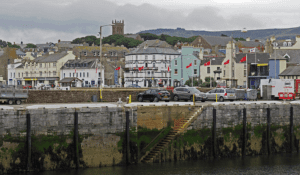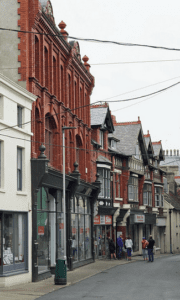Peel is the largest settlement on the west side of the island and is renowned for its stunning sunsets. On a clear day there are good views of the Mountains of Mourne and this is the place to come to see basking sharks.
Peel has a long history. Hunter gatherers from the stone age settled on “St Patrick’s Isle”:http://wasleys.org.uk/eleanor/man/central/patrick_isle/index.html and later the Irish Missionaries established a monastery here. The Vikings built a castle and it became the capital of the island during Viking times and the seat of the bishopric. A small settlement grew up round St Patrick’s Isle, which gradually became Peel.
The centre of Peel is still unspoilt with narrow streets dropping down to the sea. Michael Street, the main shopping street, has hardly changed over the years with its small family owned shops.
With the building of “Castle Rushen”:http://wasleys.org.uk/eleanor/man/south/castletown/castlerushen_one/index.html , Peel’s importance waned. Peel castle continued to be used by the Lord’s of Mann until the Civil War and continued as a garrison until the Napoleonic Wars. The cathedral was in ruins after the Civil War and attempts were made to patch it up.
St Peter’s Church in the centre of Peel was built as a Chapel of Ease for the cathedral after a boat carrying a coffin for burial was wrecked. When the cathedral fell into disrepair in the C17th and C18th, St Peter’s became the parish church.
There were plans to rebuild the old cathedral in 1870 but it was decided that it would be too great a task. Instead a new church, St German’s, was built, which would replace St Peter’s. This was consecrated as a “cathedral”:http://wasleys.org.uk/eleanor/man/churchesandcrosses/churches/churches_two/peel_cathedral/index.html in 1980.
St Peter’s Church was no longer needed and much of the building was destroyed by a fire in 1958, just leaving the tower and part of the east wall standing.
Peel became a very important fishing settlement with the River Neb providing safe anchorage. The pier and breakwater were built at the end of the C18th with further improvements in the C19th. The breakwater has deep water berths and a small lighthouse at the end.
The inner harbour has a pedestrian swing bridge and automatically operated flap gates to retain water at low tide. Fishing boats usually moor alongside the breakwater, although some also use the inner harbour. Part of the inner harbour is now a marina for leisure craft.
With the arrival of the railway from Douglas in 1873, summer visitors arrived and hotels were built along the promenade, although Peel never developed as a holiday centre in the way Port Erin did.
The railway shut in 1968 and all that remains is the water tower and a level crossing. The station was demolished and is now the site of the “House of Manannan.”:http://wasleys.org.uk/eleanor/man/central/manannan/index.html A small “transport museum”:http://www.iomguide.com/manxtransportationmuseum.php opened in the disused offices of a brickworks close to the water tower.
Peel was the main fishing port for the island, particularly catching herring. By the mid C19th over 1,700 men worked on the boats. The herring were either preserved by packing in salt or by smoking to become kippers. There are still two kipper smokeries in Peel, Devereau’s and Moore’s, although “Moore’s”:https://www.silvertraveladvisor.com/review/attraction/193819-review-moores-traditional-curers is the only one who still smokes traditionally over oak and pine chippings.
Tours are run on Monday afternoons during the summer which take you into the smoke house. The herrings are gutted, soaked in brine and then hung on racks above the wood chip fire for up to 12 hours.
There are more pictures “here.”:http://wasleys.org.uk/eleanor/man/central/peel/index.html















